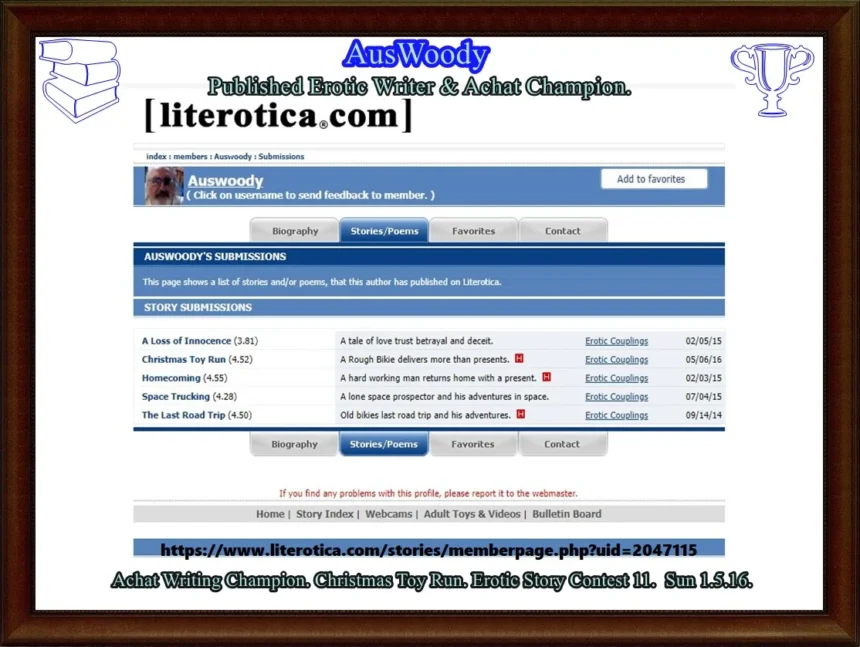Before diving into tags, we need to understand Literotica itself.
-
Literotica is a free online community for erotic fiction, where users can submit stories, poems, essays, audio, illustrated stories, etc.
-
It was launched in 1998, and it has become a major hub for amateur erotic writers. There are hundreds of thousands of stories, and millions of registered users.
-
The site includes multiple languages, and content spans many genres, kinks, relationship dynamics, etc.
Understanding this scale helps explain why tags are crucial on Literotica.
What Are Literotica Tags?
Literotica tags are keywords or phrases attached to a story by its author (or sometimes by site moderation/community convention) that describe elements of the content: theme, genre, character dynamics, sexual acts, tone, orientation, etc. They act as metadata.
Tags serve several functions:
- Let readers filter or search for content matching their preferences.
- Help authors make their stories more discoverable to the right audience.
- Provide warn-signals or content indicators — so readers know what to expect (and possibly avoid) before reading.
Why Literotica Tags Matter
1. Enhanced Discoverability & Search
Because Literotica has a vast library of stories, without good tags, even a well-written piece may remain buried. Tags allow:
- Readers to find stories with specific kinks, relationship dynamics, or themes.
- Writers to tag their stories such that they appear when readers search by those terms.
2. Reader Satisfaction & Filtering
Readers often have preferences and boundaries. Tags help:
- Show warnings about content that might be sensitive (non-consensual, taboo, etc.).
- Avoid content the reader does not want. For example, someone may want romance with soft eroticism but avoid very explicit or dark themes.
3. Ethical & Transparency Role
Because erotic content inherently carries risk of triggering unwanted responses, tags are part of maintaining ethical practices:
- Clear labeling of problematic or sensitive content allows readers to give informed consent.
- Avoiding misleading tags builds trust; mis-tagging can lead to backlash or removal.
4. Increasing Engagement for Writers
Writers who use tags well tend to:
- Get more views & feedback.
- Build loyal readership if their tagging is consistent and aligns with expectations
Common Categories of Literotica Tags
Tags can usually be grouped into several broad categories. Here are typical ones found in Literotica and similar erotic fiction platforms, with explanations:
| Category | What It Describes | Examples |
|---|---|---|
| Genre / Theme | Overarching style or setting of story | Romance, Sci-Fi / Fantasy, Paranormal, Historical, Erotic Horror |
| Relationship / Dynamics | Who-with-whom, power relations etc. | Boss/Employee, Strangers, Friends to Lovers, Age Gap, Polyamory |
| Orientation / Identity | Gender / sexual orientation of characters | Lesbian, Gay, Bisexual, Transgender, Straight etc. |
| Acts / Kinks | Sexual acts or fetish content | BDSM, Oral, Anal, Voyeurism, Exhibitionism etc. |
| Tone / Intensity | How explicit, how dark, how gentle etc. | Softcore vs Hardcore, Dark, Rough, Consensual, Explicit |
| Setting / Scenario | Where / when / special circumstances | Office, School, Outdoors, Public, Fantasy worlds etc. |
| Triggers / Sensitive Content | Dangerous or sensitive themes | Non-consensual, incest (fictional), abuse, violence etc. |
Best Practices for Writers: How to Use Literotica Tags Effectively
Here are strategies to maximize visibility and maintain integrity when tagging your stories.
1. Be Accurate and Honest
Never tag content your story does not contain. A misleading tag may get readers but will lead to negative feedback or loss of trust.
2. Use a Mix of Broad & Specific Tags
- Broad tags (e.g. Romance, BDSM) help reach larger audiences.
- Specific or niche tags capture dedicated readers (e.g. Slow Burn, Voyeurism, Age Gap).
This mix lets your story appear in both general and specialized searches.
3. Limit the Number of Tags; Prioritize Relevance
Overloading a story with dozens of tags may dilute focus. Some recommend 3-10 tags depending on the story’s complexity. Choose ones that capture the most prominent themes
4. Use Tags for Reader Expectations / Warnings
If your story includes content that may be triggering or sensitive, ensure tags reflect that (non-consensual, taboo, violence, etc.). Presentation of such themes should be transparent.
5. Update Tags When Needed
If you revise the story or add new plot elements, update tags accordingly. Also, monitor trending tags and see if adding them (if relevant) might boost visibility.
6. Study What Performs Well
Look at popular stories in your genre/subgenre. See what tags they use. This gives insight into what readers are using.
For Readers: How to Use Tags to Find Stories You’ll Enjoy
If you’re reading on Literotica, tags are one of your most powerful tools. Here are tips for maximizing their usefulness:
1. Start with Broad Themes, Then Refine
If you’re in the mood for romance or general erotica, start with a broad tag. Once you locate something closer to your taste, refine with more specific tags.
2. Use Multiple Tags in Search
Combine tags to focus your results (e.g. Romance + First Time + Public). This helps filter out unwanted content.
3. Read the Tags Before Reading the Story
Especially important when you want to avoid certain triggers.
4. Explore Niche Tags
Sometimes the most compelling content is in less obvious places. Tags like Voyeurism, Historical, Fantasy, Teacher/Student (fictional) may lead to creative or unusual stories.
5. Understand the Limits of Tags
Tags only tell part of the story. They can’t always capture tone, writing quality, pacing, or character depth. Sometimes a story with a rare tag may still align with your tastes more than one with many.
Ethical Considerations & Community Guidelines
Because Literotica deals with erotic content, certain ethical and legal issues arise. Tags play a role here.
1. Consent, Age & Illicit Behavior
- Tags indicating non-consensual, incest, or underage are sensitive. On many platforms, actual underage content is disallowed. Fictional portrayal can be controversial or disallowed depending on specific platform rules. Readers and writers must be clear and aware.
- Make sure consent dynamics are clear where relevant. Misleading tagging in such areas can damage trust and violate terms.
2. Trigger Warnings
While Literotica might not always have a formal trigger warning system, tags serve as informal warnings. Writers should thoughtfully tag if there’s violence, abuse, non-consent, etc.
3. Avoiding Misuse of Tags
- Mis-tagging for “clickbait” (i.e. using popular tags but delivering very different content) is frowned upon.
- Using tags that are irrelevant or misleading may lead to reader dissatisfaction or site moderation.
4. Cultural Sensitivity & Respect
- Be mindful of stereotypes—gender, race, orientation.
- Some tags may carry different connotations in different cultures.
- Even in erotic fiction, respectful representation matters.
SEO Implications: Tags Beyond Literotica
Even though tags are internal to Literotica, they also matter for search engines:
- Many Literotica stories are indexed by Google. If your tags align with terms people search externally (e.g., “teacher/student erotica”, “BDSM romance short story”), your story may rank in Google search results.
- Good tags can help with metadata and page titles (depending on how Literotica displays them) which improves click-through rate from search engine result pages.
Common Tags & What They Mean
Here are explanations of some of the most common Literotica tags, especially ones that are frequently used or controversial.
| Tag | Meaning / What to Expect |
|---|---|
| BDSM | Power dynamics, dominance/submission, possibly pain, control. Consensual. |
| Romance | Emotional connection, slow burn, often with sensual scenes. |
| First Time | A character losing virginity or sexual inexperience; may involve nerves, awkwardness. |
| Lesbian / Gay / Bi | Sexual orientation tags; relationships between same gender characters or involving more than one orientation. |
| Taboo | Theme seen as socially forbidden; may include age differences, step-relations, roleplay, etc. Needs to be handled ethically. |
| Non-consensual / Dub-con | Very sensitive; includes scenes where consent is questionable or coerced. Tagging must be very transparent. |
| Public / Exhibitionism / Voyeurism | Acts in public or semi-public, possibly risk or being observed. |
| Fantasy / Sci-Fi / Paranormal | Settings or elements beyond realistic: aliens, magic, mythical beings, supernatural. |
| Explicit / Hardcore | Very graphic sexual descriptions. |
| Soft / Erotica | Less graphic, more about sensuality, mood, erotic tension. |
Tag Mistakes & What to Avoid
Writers (and readers) should be aware of common pitfalls around tagging:
Over-tagging
Adding too many tags hoping to capture every possible reader can backfire — dilute focus, look spammy, mislead about the story’s content.
Misleading Tags
Putting a tag for a theme that barely appears, or appears just once but seems central. Readers expect tag relevance.
Ignoring Sensitive Tags
Failing to tag content that would be triggering or problematic for some readers.
Outdated or Unrecognized Tags
Using tags that no longer exist or are rarely used on the platform may reduce discoverability.
Inconsistent Tagging Across Series or Chapters
If a story is part of a series, or if later chapters introduce new content, tags should be updated to reflect that.
Trends & Emerging Patterns in Literotica Tags
While specific data from Literotica is not always publicly shared, community sources and meta-analysis suggest some trends:
- Certain niche tags grow in popularity when broader cultural or media trends emerge (e.g. paranormal romance, fantasy erotica, alternate orientations).
- Increase in demand for orientation tags and inclusive sexual identities (transgender, non-binary, etc.).
- Growing awareness of triggers and more careful use of sensitive tags.
- Authors updating or refining tags of older works to align with newer tastes or trends.
- Some stories gain visibility simply because they use tags that are trending, even if the story is older.
Best Practices Checklist for Writers Using Literotica Tags
To sum up the advice, here’s a checklist you can use before publishing a story:
- Identify the main theme(s) of your story.
- Choose 1-3 broad genre tags (e.g. Romance, Fantasy, BDSM) that cover the framework.
- Add 2-4 specific tags that highlight key features (e.g. “First Time”, “Voyeurism”, “Boss/Employee”).
- Tag any sensitive or potentially triggering content explicitly.
- Avoid tags for content that doesn’t appear or is minimal.
- Look at similar stories in your genre to see what tags they use.
- Stay consistent if writing multiple stories or chapters.
- Periodically review tags for older stories to update with new relevant ones.
- Use tags that match what readers are likely to search for (both within Literotica and externally).
Limitations & Things Tags Can’t Do
Tags are helpful but are not perfect. Some of their limitations:
- They can’t fully communicate writing style, quality, character voice, or plot pacing.
- Sometimes tags can damage the reading experience by setting expectations too high (if the story does not fulfill all implied themes).
- Tags depend on author honesty and community moderation; misuse is possible.
- Cultural differences and language may cause confusion around tag meaning.
Conclusion
Literotica tags are far more than simple labels. They are powerful tools that connect writers and readers, help in discoverability, play roles in ethical transparency, and influence how the erotic fiction community interacts.
For authors: using tags accurately, strategically, and ethically can increase reach, build trust, and enhance engagement. For readers: reading and filtering by tags allows more satisfying and safer exploration of content.
If you’re writing on Literotica or reading there, paying close attention to the tags will greatly improve your experience—whether you want intense kink or gentle romance, niche fantasy or specific kinds of dynamics.
FAQs
Q1: How many tags should I use for a single story?
Generally between 3-10 tags is considered a good range. Enough to cover major themes and unique aspects, but not so many that the story seems unfocused or misleading.
Q2: Can I add my own custom tags?
This depends on Literotica’s current system. Often authors can choose from existing tag lists; in many cases custom tags are limited or moderated to avoid abuse or confusion.
Q3: What happens if my story includes a sensitive theme?
You should tag it explicitly with the relevant content tags (e.g., non-consensual, taboo, incest [if fictional and allowed], etc.). Transparency is key for ethical engagement and for avoiding complaints or negative ratings.
Q4: Will using popular tags always give me more views?
Not always. While popular tags help, they also mean more competition. Sometimes niche tags can bring in loyal readers who are specifically looking for what you provide. A balanced approach is best.
Q5: How often should I revise tags?
Whenever your story’s content changes significantly, or if you observe new trends or tags becoming popular. It’s good to occasionally review older works to update tags so that they match current reader interests.








